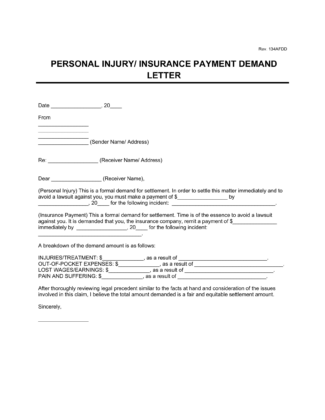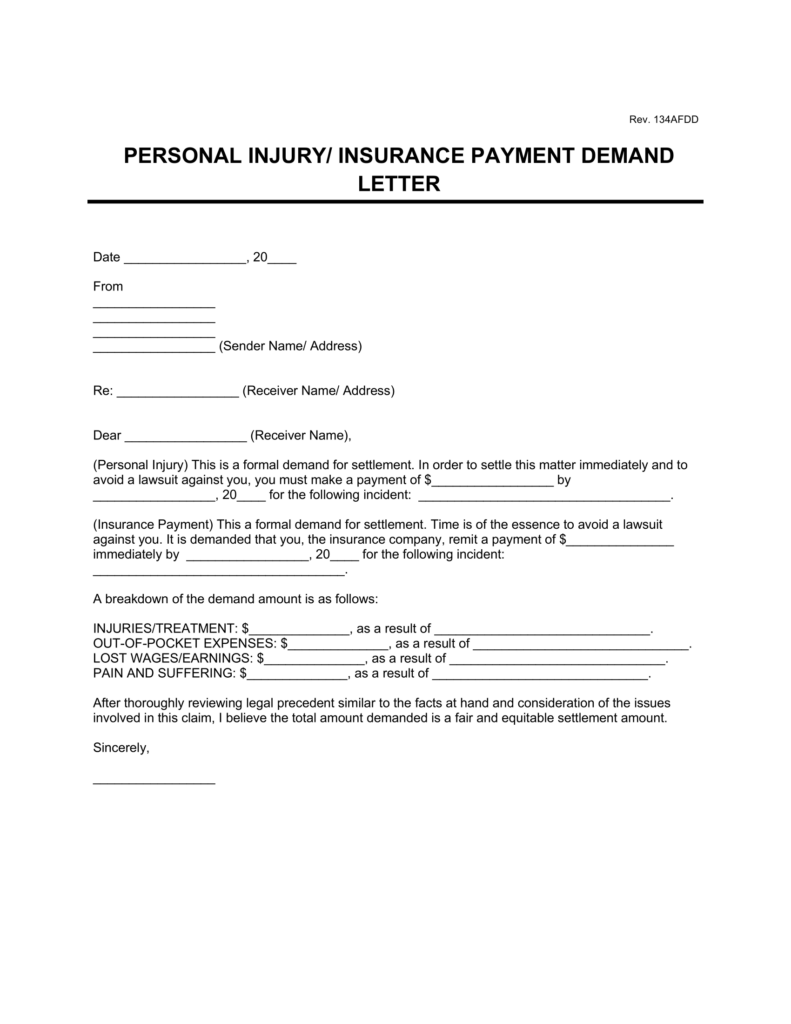
Use our free demand letter template to claim compensation for the harm suffered as a result of the accident.

Updated July 24, 2023
Written by Ioana Gagiuc | Reviewed by Brooke Davis
You can write a personal injury demand letter to kickstart settlement negotiations if you’ve been injured after an accident. Settlement negotiations can compensate you for the harm you suffered from the accident.
Use our personal injury demand sample letter to start creating personal injury demand letters. Feel free to change and edit the sample letter’s language as needed.
A personal injury demand letter attempts to end a lawsuit and avoid going to trial by asking the at-fault party and their insurance party to pay for a reasonable settlement amount. This document is also called a demand letter or settlement demand letter.
You can use demand letters to:
Although it’s possible to write and file an effective personal injury demand letter yourself, we recommend getting an experienced attorney to file one on your behalf. That’s because insurance adjusters don’t have your best interests in mind. As such, they can easily convince you to accept a lowball settlement amount.
An experienced personal injury attorney can negotiate with insurance adjustors and secure a fair settlement amount.
Download our demand letter template to start a personal injury claim.

You need a personal injury demand letter whenever you are faced with recovering settlement damages after an accident. Here are some common scenarios that require you to write your demand letter:
The contents of personal injury demand letters vary depending on your case. However, most personal injury demand letters include the following:
All personal injury demand letters must specify the parties involved in the accident, insurers included. You should also have the at-fault party’s insurance policy number. After identifying the parties, you should summarize the letter’s purpose with one or two sentences.
Structured in this way, your letter will:
Here’s what this part of the letter could look like:
[Date of the letter]
FOR SETTLEMENT PURPOSES ONLY
Dear [at-fault party’s claim adjuster’s name]:
As you already know, on [date of the accident], I was seriously injured in a car crash caused by your insured, Bob Jones. The evidence below clearly shows that your insured’s negligence was the cause of my injuries and losses.
These include economic damages like medical bills and out-of-pocket expenses and non-economic damages such as pain and suffering.
Once you’ve established the parties, outline the circumstances of your injuries. Explain how the accident happened and how you were injured.
Here’s what this section could look like in your letter:
On [date of the accident], at [time], I was driving my [car model] southbound on [street name]. I was wearing my seatbelt and paying attention to the traffic signals, the road, and other vehicles in my sight.
Suddenly, as I approached the intersection of [road name] and [road name], your insured’s [car model] violently collided with the front of my car as they made a left turn from [road name]. The immediate force of the impact spun my car around until it crashed into a nearby bus shelter.
Next, detail the injuries and damages you suffered due to the accident.
To maximize settlement amounts, you should describe the following:
Highlight the length and difficulty of your recovery, your pain and suffering, and any other adverse effects your injuries have had on your lifestyle, such as emotional distress. Remember to back up your claims with medical records from your doctor.
Here’s what this part of the letter could look like:
Right after the accident, I was rushed by ambulance to [hospital name] with initial complaints of head pain, back pain, and left wrist pain. When I arrived at [hospital name], it was two in the morning. According to the doctors, I had suffered the following injuries:
Photos of my diagnoses and injuries are attached.
It has been a challenging year since the accident happened. Since the crash, I have suffered the following:
My medical expenses have totaled $30,000 since the date of the accident. All receipts and reports are attached to this demand letter.
Finally, it would be best to outline the compensation you deserve in your personal injury claim. You can determine your compensation amount by adding your economic and non-economic damages.
Economic damages refer to compensation for monetary losses like current, past, and future medical expenses and loss of future earnings. Meanwhile, non-economic damages refer to non-monetary and subjective losses like inconvenience, pain, suffering, and loss of enjoyment of activities.
You can calculate economic damages by looking at your pay stubs, medical bills, and pharmacy charges. As for non-economic damages, there’s no single way to quantify them.
However, most personal injury attorneys and insurance adjusters use multiple medical expenses to determine non-economic damages. A typical noneconomic damages multiplier is two or three, but your attorney may use a higher multiple if your injuries are permanent and severe.
To continue from the previous example, your lawyer would probably multiply your medical expenses ($30,000) by three since your injuries were not particularly severe for a car crash. This would mean your non-economic damages are $90,000. Your total compensation amount would thus be $120,000.
A personal injury demand letter is an official document. As a result, you must avoid the following when writing it:
It’s normal to feel frustrated and wronged after an accident.
However, creating a negative mood will decrease your chances of reaching a reasonable settlement. Remember, the letter aims to show the at-fault party and their insurance company that you are serious about recovering damages.
It also gives them a chance to consider their legal choices.
Also, remember that the judge will read your personal injury demand letter if the dispute goes to trial. You are unlikely to recover total damages if the judge perceives you as antagonistic.
If you include these details, the at-fault party’s lawyer will focus on them and try to paint you as the responsible party. This will happen even if your role is minor.
The description of the accident should not be too detailed. The more complex it is, your letter will likely conflict with the police report and your subsequent and earlier statements.
The opposing lawyer will use these inconsistencies to prove you cannot be trusted.
Insurance companies often consider unreasonable compensation demands unserious offers to settle personal injury cases. As a result, the insurance company may be less willing to negotiate out of court.
You now know what to include and what not to include in a personal injury demand letter. Follow these steps to write an effective personal injury demand letter:
The best way to write a personal injury demand settlement letter is to start from a sample letter or template . Alternatively, our document builder allows you to create your demand letter by simply answering a few questions.
Add your full name on the form and date the document. If your attorney writes this for you, they will write their name instead. They will mention your name and their relationship with you in the body of the letter.
Next, explain how the accident caused your injuries and what injuries you sustained. As mentioned in the “What to Include on a Personal Injury Demand Letter” section above, you should be specific and concise.
Consider attaching and referencing photos and doctor’s reports to substantiate your claims.
List the current, past, and future economic and non-economic damages you deserve. Then, advise the recipient of the letter that there is an opportunity for the at-fault party to settle for your proposed settlement account.
Finally, you should send the personal injury demand letter through certified mail and request a return receipt. That way, you will have proof that the letter was received and delivered.
You should send your personal injury demand letter well before your state’s statute of limitations begins.
In personal injury, a statute of limitations is a law that sets the maximum time that parties have to start legal proceedings.
The statute of limitations varies depending on your state and the type of accident, but it is usually two years from the date of the accident that caused your injuries.
There is no set timeline for settlement cases. Once you send your personal injury demand letter to the at-fault party, the party will control how fast the claim moves.
If the at-fault party agrees with your settlement, which is unlikely, they may send you a settlement check within several days. However, if they disagree with the terms of your offer, which is much more likely, the at-fault party may take weeks or months to accept.
That depends on the damages you’ve suffered. Generally, you should ask for 75% to 100% more than your total damages. If you start too low, the insurance company will probably respond with something even lower.
If you do not receive a response to your demand letter, you should send one final demand letter. This is typically a short and sharp letter that includes your previous letter as an attachment, giving the party more time to comply with the demand.
If the recipient does not respond to the final demand letter, your next action is to file a lawsuit. Your attorney will walk you through filing a personal injury lawsuit.

Create your own in minutes!